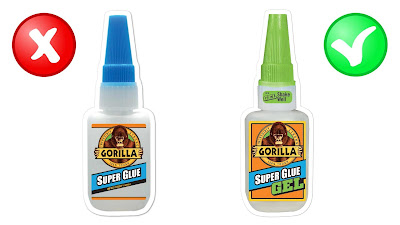After my last post on adding plants to the Shy Guys jungle tank, I wanted to delve a little deeper into the use of super glue in aquascaping. Cyanoacrylate, the primary ingredient in super glue, is aquarium-safe and is totally a miracle tool for attaching plants to hardscape (compared to hand-tying plants using sewing thread). Over time, I’ve picked up more and more clever ways on how to apply this stuff.
Tip 1: Use super glue gel
For those of you who didn’t know, super glue is commonly used to attach moss and rhizome plants (like anubias and java fern) onto hardscape such as rocks and driftwood. And you don’t want to use regular liquid super glue, but rather super glue gel. The gel type is thicker and easier to manipulate when it comes to attaching delicate plants exactly the way you want.Tip 2: Glue the roots of the plant
Now when you’re gluing down the rhizome plants, make sure not to glop it all over the rhizome. I’ve totally killed off some anubias nana petite because it was so tiny and I ended up suffocating the plant with glue. Instead, focus on gluing the roots down, and your plant will do just fine.Tip 3: To avoid sticky hands, use nitrile gloves and the bottle cap
The problem with super glue is that it’s really easy to accidentally get it all over your hands, so wear nitrile gloves to protect your skin. Also, use the cap of the super glue bottle (rather than your fingers) to firmly press the plant down for 30 seconds. Super glue cures fairly quickly in water, but I find that I still need to hold the plant in place for that initial drying period in order to get a firm bond.Tip 4: Cover the glue with sand or soil
Word of warning: once the glue is placed in water, it will dry into a white color that a lot of people don’t like (which is another reason why you should use the glue sparingly). However, you can sprinkle and rub in some sand, soil, or other fine substrate into the glue as it’s curing, which totally hides the white color and gives it a more natural appearance. |
| White super glue in a planted tank (source: StrungOut) |
Tip 5: Use glue and sewing thread for more stability
As awesome as super glue is, unfortunately it’s not always sufficient for holding together top-heavy plants. In my previous video, I mentioned that I have a very large anubias in the Shy Guys tank that hides the sponge filter, and what I did was first glue its roots onto the rock, and then I used some green sewing thread to tie it down for more stability. Without the thread, I find that these taller plants can sometimes fall over and break the glue bond.Tip 6: Glue stem plants to rocks to weigh them down
Remember how in my previous post, plants kept floating away from the substrate? Instead of using plant weights, just use a little bit of super glue gel to attach the base of your plant to a small lava rock. (You can use any type of rock, but lava rock is very porous, which gives the roots something to grip onto.) Then bury the whole rock and it’ll keep the plant weighted down until the roots get established. How cool is that!Tip 7: Use glue to attach driftwood together
In fact, super glue isn’t just for plants; you can also use it to connect driftwood pieces. For example, if you wanted to create an underwater tree, you can attach little sticks to a larger stick (the trunk) with super glue gel and then just chip off any excess glue with an X-acto knife. Check out SerpaDesign’s awesome moss ball tree as an example. |
| Moss ball tree created with super glue (source: SerpaDesign) |
Tip 8: Use glue to attach rocks together
Amazingly, you can actually attach hardscape rocks together to make the perfect aquascape. Jurijs Jutjajevs is a famous German aquascaper who shows off this crazy technique where you rubber band the two rocks together, put a fluffy piece of cigarette filter in the crack in between, and then lightly soak the filter with liquid super glue (not super glue gel that we usually use). I haven’t tried this yet, so check out his tutorial for the full instructions.None of my plants or fish or shrimp have ever died from using super glue (except for that first anubias nana petite), so don’t be afraid to use this miracle adhesive to create that dream aquascape stirring around in your head!
Question of the Day
What tips do you have for using super glue in aquariums? Comment below to share your experiences because I’d love to hear them. Take time to enjoy your aquariums and I’ll see you next time!Subscribe to my YouTube Channel for practical fish care tips for busy aquarists and follow me on Instagram for more updates! 🎮❤️🐟











